Cable news turned to video walls, floating cam for SCOTUS audio-only coverage
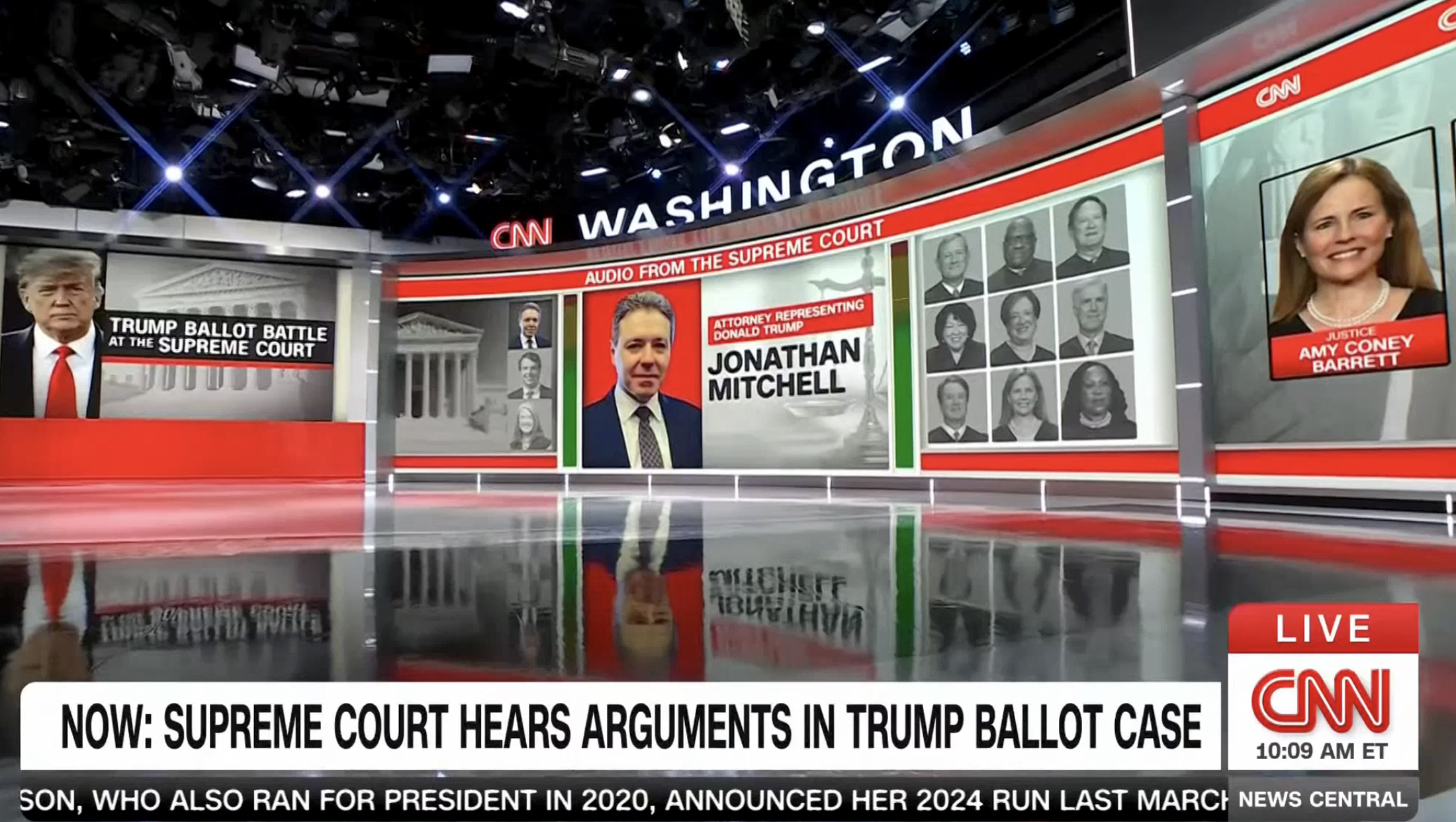
Subscribe to NCS for the latest news, project case studies and product announcements in broadcast technology, creative design and engineering delivered to your inbox.
When audio’s the star of the show, television producers and directors often have to get creative to find a way to keep things interesting from a visual standpoint — and cable news’ coverage of the Feb. 8, 2024, Supreme Court hearings in Trump v. Anderson broke out a combination of video walls and floating cameras.
CNN, MSNBC and Fox’s cable channel all carried the full audio of the hearings live and uninterrupted the morning of Feb. 8, with pre- and post-coverage as well.
With cameras barred from the Supreme Court and live audio feeds from the courtroom still a relatively new offering brought on due to the pandemic, the Feb. 8 hearing marked an instance of high-profile case arguments being carried by cable news in its entirety.
All three networks opted for a similar basic concept — they leveraged a combination of the large seamless video walls and smaller, standalone monitors that have become nearly ubiquitous in TV studios and another mainstay of the medium — the “walk and wander” floating camera.
These “video on video” shots are generally obtained by a camera that’s being operated by a human operator who is physically holding the camera apparatus near their body, as opposed to a jib, robotic camera or traditional ped — allowing for broader and more dramatic moves than might otherwise be possible.
Each network did, however, have slightly different takes on how the video walls helped guide the story playing out in the courtroom.
CNN originated most of its coverage from its Washington, D.C., studio, which is outfitted with numerous video walls.
The network typically displayed a lineup of the justices on the longer, flat installation, while the neighboring curved segment was typically used to spotlight who was speaking.
The network divided the wall into three distinct segments, the far left one used to showcase headshots of the attorneys arguing before the court and the right one featuring a three-by-three grid of each justice.
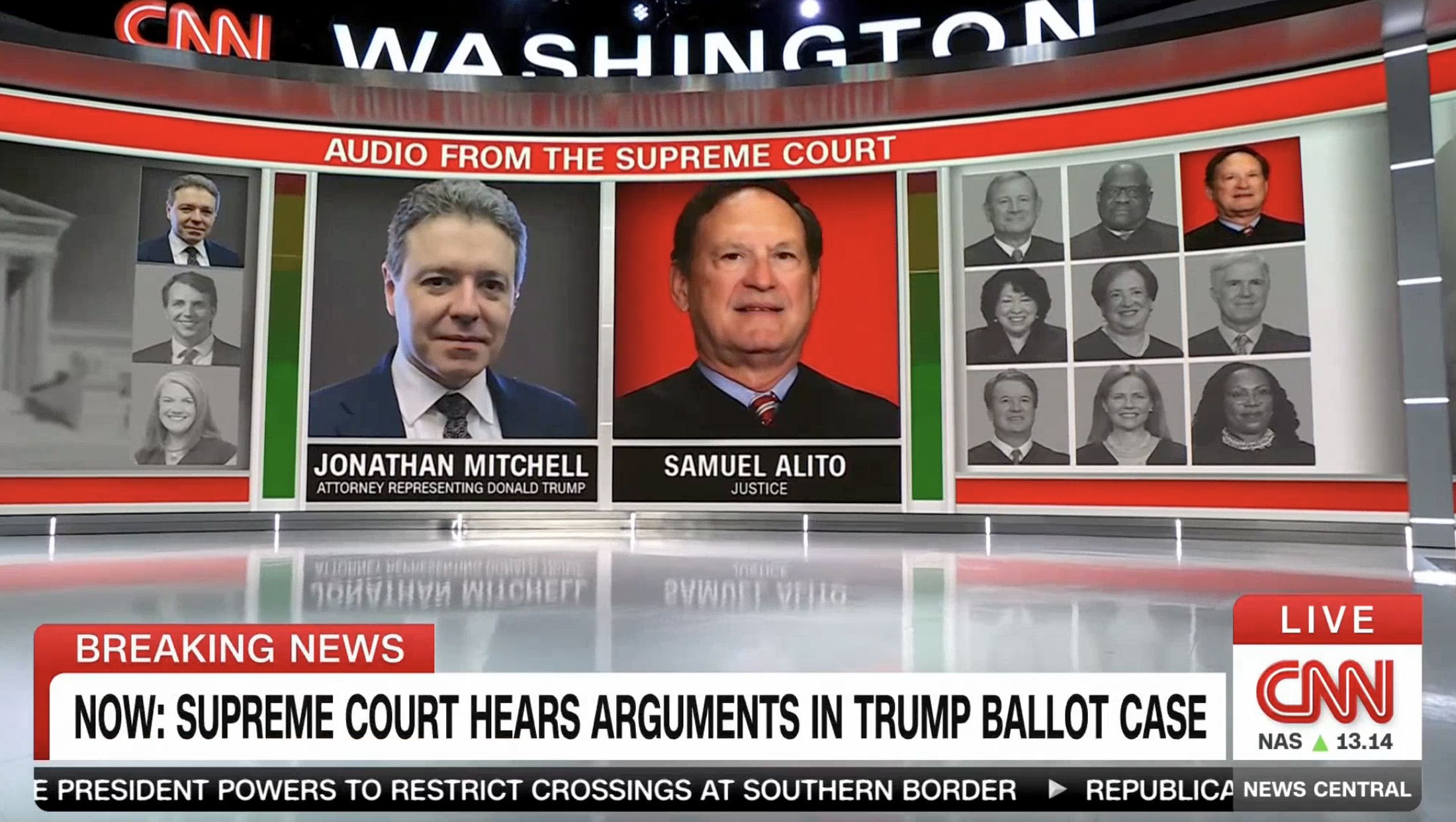
When a particular justice or attorney spoke, his or her photo shifted from black and white to color — and also gained a bold red background.
Larger version of their headshots were shown in the center segment of the video wall, which was framed by two vertical audio meter-style images that appeared to be synched to the realtime feed.
In cases where there was more back-and-forth between a justice and attorney, two headshots could be shown in the center area.
Overall, these graphics also included simulated columns and frames. Combined with the red stripes with beveled borders running along the top and bottom of the video wall, these graphics suggested the notion that there was some structural elements to the screens — a toned down version of the network’s quasi-virtual set extension look used on other programming.
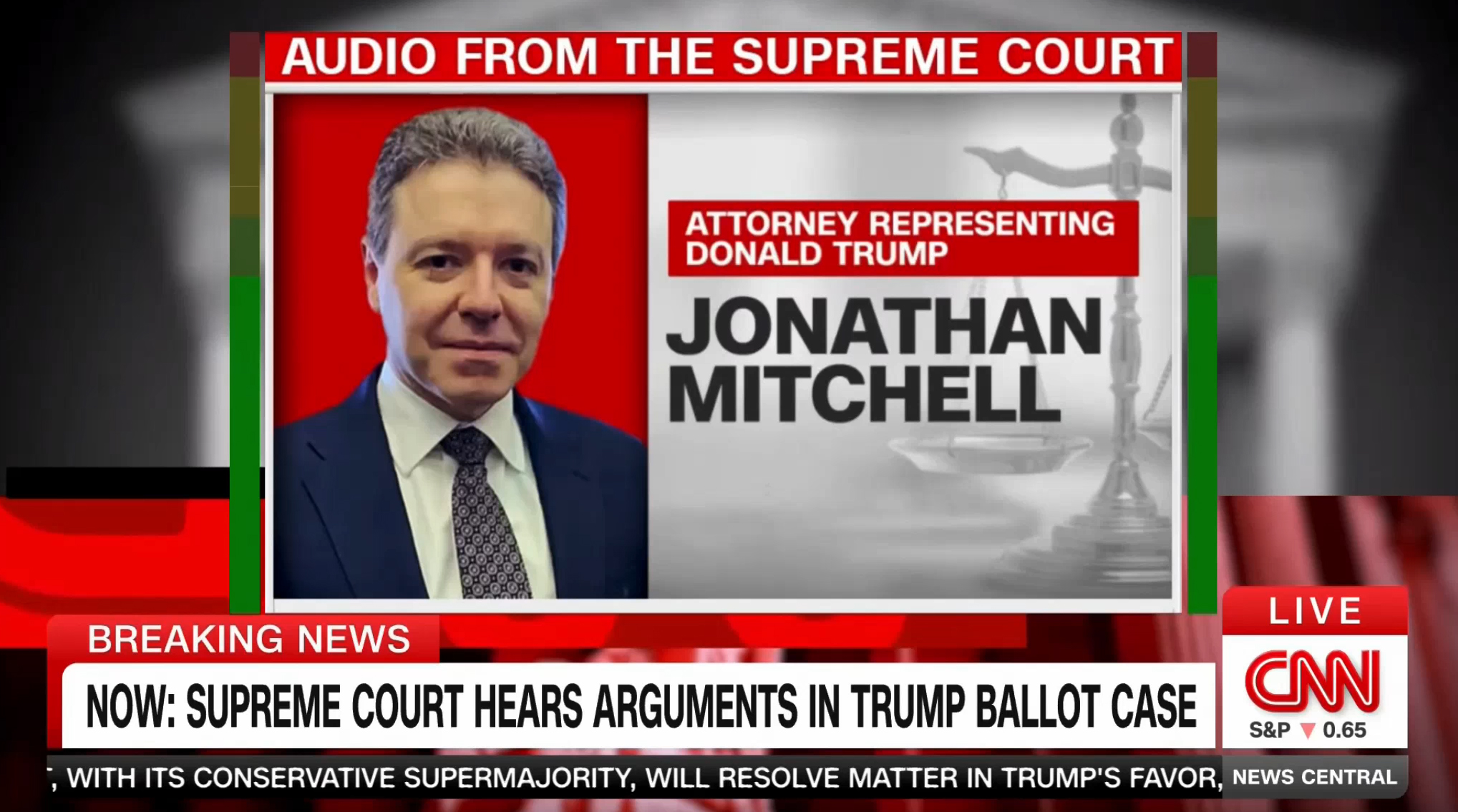
This center image could also be taken fullscreen if needed, set against a background with simulated meters on either side.
It appeared that the fullscreens were used when a camera shot needed to be adjusted in a way that wouldn’t have maintained the smooth floating feel typically seen on air.
Because the cause involved key parts of the 14th Amendment, CNN also had scroll-like video wall graphics showing the text of the U.S. Constitution. These were typically fed to the smaller video wall with red knee wall located to one side of the curved video wall.
CNN branded its coverage as “Trump Ballot Battle at the Supreme Court” (sometimes shortened to just “Trump Ballot Battle) with a combination of muted photo backgrounds blended with red, white and black graphics and overlays.
Over on MSNBC, coverage originated from the east side of Studio 3A, with the space’s L-shaped anchored desk set up in the corner created using two intersecting video walls.
The network used a slightly redder version of the graphics it has used in the past for coverage of Trump’s legal troubles. This look includes black Xs that appear hand-drawn and textured typography and the title “Trump Ballot Battle,” which, in some versions, used a box-like element similar to the Trump campaign logo.
To showcase visuals during the extended audio segments, MSNBC used the floor-to-ceiling video wall with so-called “Kornacki curve” ribbon that flows out of the flat surface along with one of the mobile video panels positioned at the end of the LED strip.
It also used the additional narrow video wall segments found on either side of the opening to the green screen box studio located behind the studio’s west sliding wall elements in conjunction with the ceiling-mounted vertical panels in front of the glassed-in hallway.
MSNBC used the curved segment to showcase the nine justices and then would typically bounce back and forth between either side of the studio to showcase photos of who was speaking.
At one point, a camera zoomed in on Justice Clarence Thomas’ photo, which was roughly in the center of the row of headshots to the point that a moiré started appearing on the video wall; it quickly corrected course and pulled back slightly to eliminate the issue.
The curved was also used to display side-by-side photos of an attorney and justice during cross-talk, while the vertical panels on the opposite side of the space could also be used for a similar purpose.
On this wall, the camera would typically move in to only showcase the attorney’s photo when he or she was speaking while a live feed of the exterior of the Supreme Court building was shown on the video wall in the background. The operator would often pull back to get a wide view of both photos when needed.
By bouncing back and forth between sides, MSNBC was likely able to “cover” instances where graphics needed to be switched out or the camera needed to change positions quickly.
It appeared that MSNBC was employing both a handheld camera and one of the studio’s robotic cameras to capture the video walls as opposed to having two separate handhelds in the space, though it was not immediately clear how the space was staffed or what gear was used.
MSNBC’s coverage lacked any clear visual indicator of who was speaking at any one time, so if two portraits were visual on-screen at any one time, it wasn’t necessarily apparent who was talking.
Like CNN, MSNBC also had a scroll-like design to showcase excerpts of the Constitution, which were typically shown on the mobile monitor unit positioned at the end of the curve.
Fox’s coverage of the hearing originated as part of its “America’s Newsroom” program with the “alert” and “breaking news” tags also used.
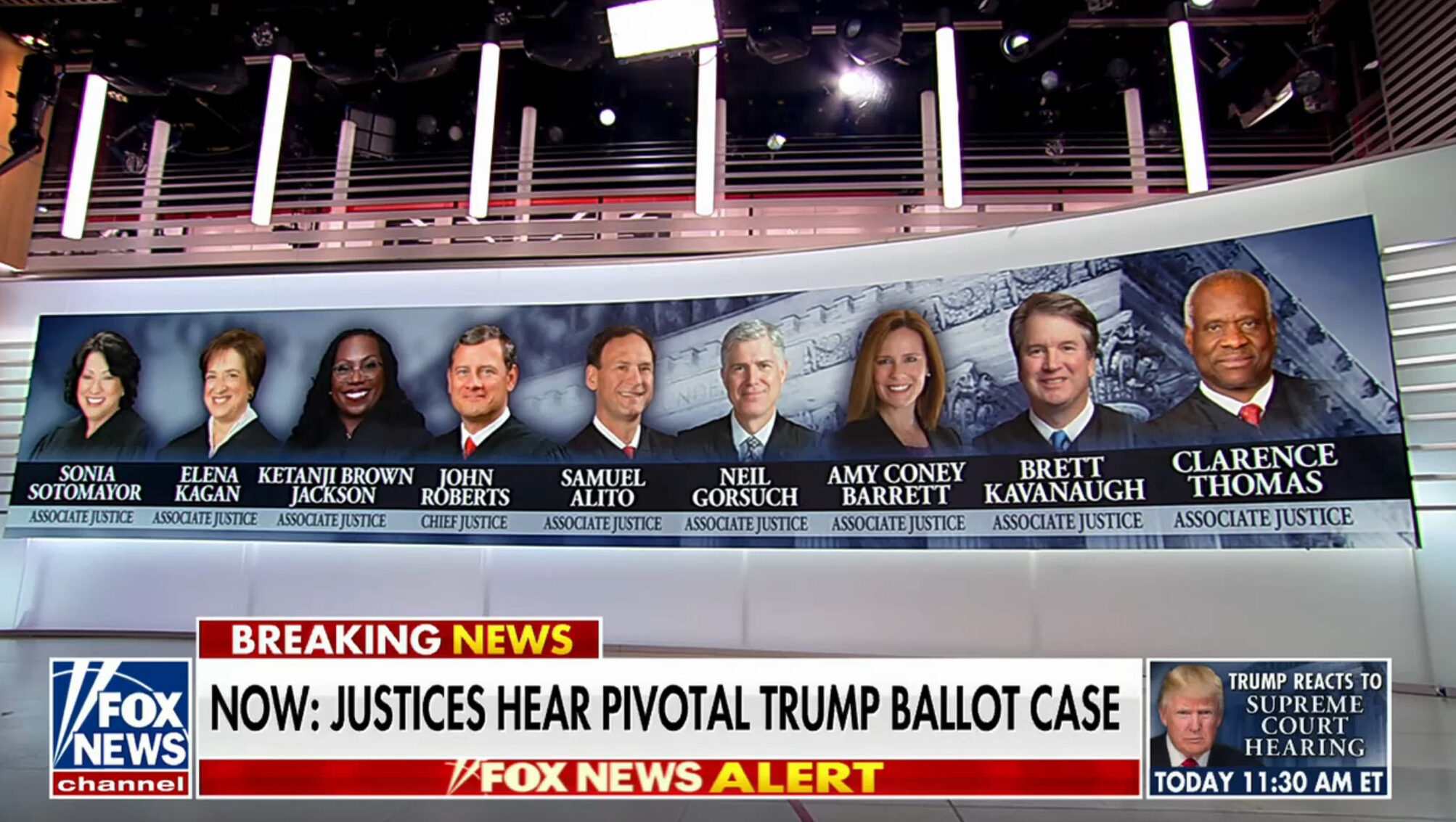
Coverage broadcast from Studio J, the normal home of “America’s Newsroom,” that is outfitted with multiple video walls.
The longer, partially curved one running along one wall was typically used for showing justice photos set against a blue tinted image of the Supreme Court building, while similar graphics on the smaller array located on one end of the studio would be used to showcase who was speaking.
Fox also used the studio’s smaller monitors on both ends of the set to showcase additional imagery, typically loops of stills of Trump.
Fox used a blend of Adobe Garamond (notable for its distinct capital “A” and “R”) and its normal sans serif, Futura.
In addition to these two video walls, Fox also employed the taller installation, typically as a way to showcase the exterior shot of the court building. The nearby smaller screen was also used in wider views, which also showcased the movable LED ribbon that was showing a scrolling “High Stakes Supreme Court Hearing” logo.
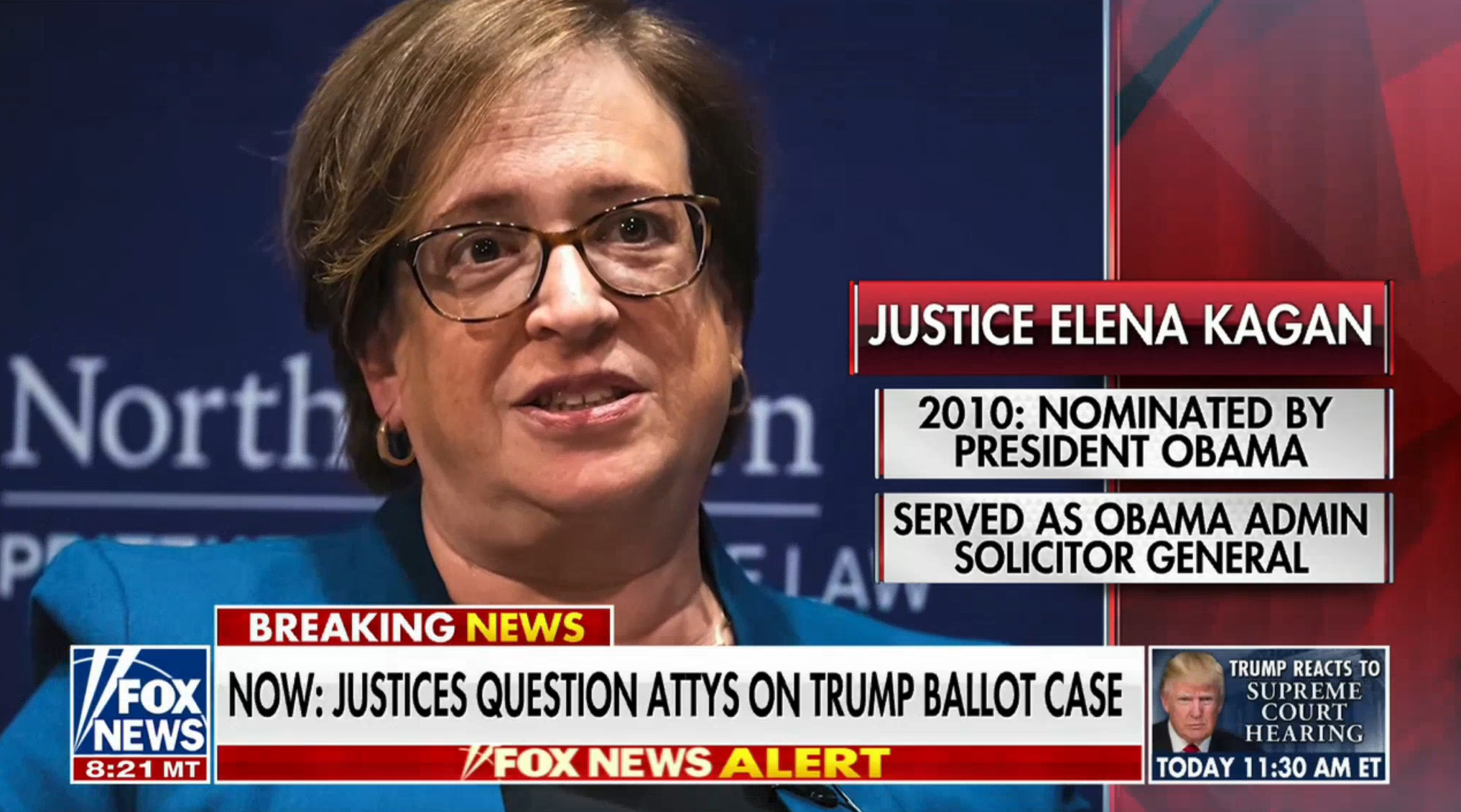
Fox also added in side-bar style graphics with key facts about specific justices as a “Ken Burns” style collection of still photos played in the adjacent space.
The blue look was also repeated in the promo box in the lower right corner that appeared during much of Fox’s coverage plugging Trump’s planned response to the hearing.
Overall, all three networks appeared to hit a few bumps in the early parts of the feed, with camera shots and transitions generally smoothing out as the hearing unfolded.
That’s not to be unexpected; it often can take some time for the control room to get into the flow of a broadcast.
CNN’s look, which highlighted who was speaking in near-realtime was perhaps the most effective, with MSNBC coming in behind that.
Fox’s coverage was often at least somewhat awkward throughout much of the hearing, with cameras having to hang out on a video wall for what seemed like too long. In general, it felt like the network was a bit unprepared for coverage in terms of available graphics.
It’s worth noting how complex it was to pull off this style of coverage. Although there was a general outline of how proceedings would go, the coverage still needed to be monitored in real time to swap out graphics as needed, requiring skillful use of sophisticated real-time graphics systems that were feeding multiple video walls or screens at any one time.
The handheld camera operators also had to be on their toes and, in some cases, get a bit creative when they had to hang out for a while on a particular screen, which could be particularly challenging given that it wasn’t always clear how long someone would be speaking.
Subscribe to NCS for the latest news, project case studies and product announcements in broadcast technology, creative design and engineering delivered to your inbox.






tags
CNN, Fox News, Kornacki Curve, MSNBC, Studio 3A, Video on Video, Video Walls, Walk and Wander
categories
Broadcast Industry News, Cable News, Elections, Graphics, Heroes, Video Wall Graphics, Video Walls